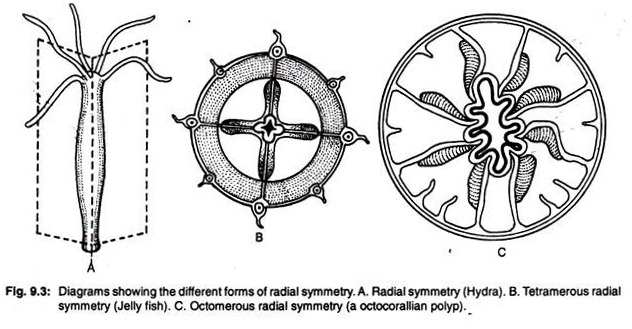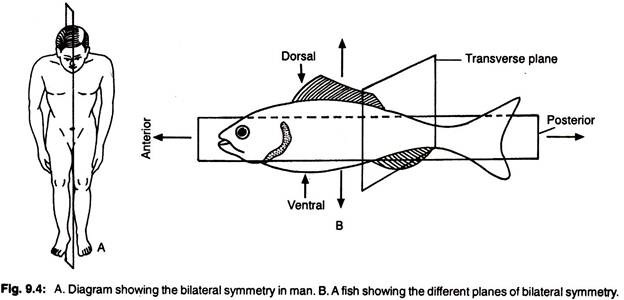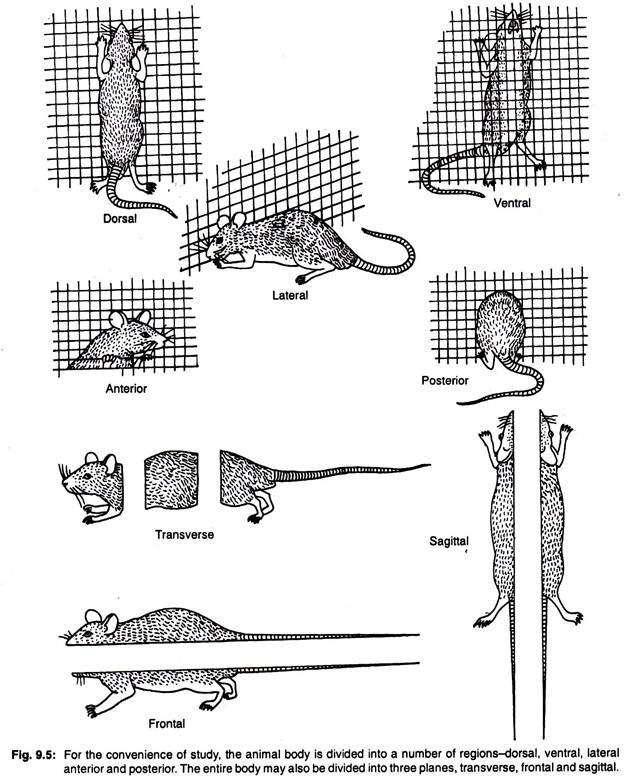What Two Types Of Symmetry Do Animals Have
The following points highlight the five principal types of symmetry seen in animals. The types are: 1. Asymmetrical Symmetry 2. Spherical Symmetry 3. Radial Symmetry four. Biradial Symmetry 5. Bilateral Symmetry.
Blazon # 1. Asymmetrical Symmetry :
In some animals there are no body axis and no plane of symmetry, hence the animals are called asymmetrical. The amoeboid forms (east.g., Amoeba) and many sponges take irregular growth design of the body and cannot be divided into two equal halves (Fig. nine.ane).

Type # ii. Spherical Symmetry :
In spherical symmetry the shape of the torso is spherical and lack whatsoever axis. The body tin can be divided into two identical halves in any airplane that runs through the organism's centre. In asymmetrical symmetry and spherical symmetry the polarity does not exist and spherical symmetry is seen in radiolarian protozoa (Fig. nine.2).

Type # 3. Radial Symmetry :
In radial symmetry the body can exist divided into two roughly equal halves by whatever one of many vertical planes passing through the central axis (Fig. ix.3A-C) like the spokes of a bike. The animals which exhibit primarily radial symmetry are cylinder in grade and the similar parts of the body are bundled equally around the axis. The axis extends from the centre of the oral cavity to the centre of the aboral side.
The radial symmetry is seen among the sessile and sedentary animals such as in some sponges, hydroids, anthozoan politicianyps, medusae and ocean stars.
Special forms of radial symmetry are observed in different groups of animals such as:
(i) Tetramerous symmetry:
Many jelly fishes possess 4 radial canals and the body tin be divided into 4 equal parts. Hence the animals exhibit tetramerous raidal symmetry (Fig. 9.3B).
(two) Pentamerous symmetry:
Most echinoderms possess pentamerous radial symmeendeavor considering the torso can exist divided into 5 roughly equal parts (Fig. twenty.1). The body parts are arranged around the axis of the mouth at orientations of 72° apart. The larvae of echinoderms are bilaterally symmetrical merely acquires radial symmetry in adult stage. The radial symmetry of echinoderms is regarded as a secondary acquisition.
(three) Hexamerous symmetry:
The sea anemones and truthful coral polyps belong to the subform Hexacorallia (course Anthozoa). The mesenteries and tentacles are arranged in the multiple of vi. The mesenteries are usually paired and are bundled in the multiple of vi. The body of hexacorallian polyps exhibits hexameric plan and have sixfold internal symmetry.
(iv) Octomerous symmetry:
The body of octocorallian polyps (subclass Octocorallia) shows octomeric radial symmetry and contains 8 hollow marginal tentacles and viii mesenteries and the body can be divided into eight equal parts (Fig. 9.3C).

The animals with radial symmetry do not have anterior and posterior sides or dorsal and ventral surfaces. They have a mouth bearing oral side and the side abroad from the mouth called the aboral side.
Type # 4. Biradial Symmetry :
The torso of animals which exhibits biradial symmetry, represents a combination of both radial and bilateral symmetry. The organs are bundled radially and the body can be divided into two past a mid-longitudinal plane. Ctenophores exhibit biradial symmetry.
Type # 5. Bilateral Symmetry :
In bilateral symmetry the body parts are bundled in such a manner that the animal is divisible into roughly mirror image halves through 1 aeroplane (mid sagittal plane) but (Fig. 9.4A). This plane passes through the axis of the torso to separate the 2 halves which are referred to as the right and left halves.
The animals which exhibit bilateral symmetry chosen bilateria. Bilaterally symmetrical animals include acoelomates, pseudo-coelomates and eucoelomates among invertebrates and both lower chordates and vertebrates.
The unabridged trunk of a bilateria can be divided into three planes such equally— (i) frontal (2) sagittal and (iii) transverse (Fig. ix.4). Any of the vertical planes perpendicular to the sagittal airplane that passes through the body separating the upper and underside is called frontal plane.
The upper-side is also called dorsal which is usually away from the ground and near the back of the animal. The underside is besides chosen ventral which is usually facing towards basis. A longitudinal airplane that passes forth the centrality of the body of bilaterally symmetrical fauna to separate correct and left sides is called the mid- sagittal plane (Fig. ix.4B).

An imaginary plane that crosses the body, perpendicular to the mid sagittal airplane called transverse plane. The body of bilateria has the term lateral (two sides of the body), anterior (the cease which usually moves forwards during movement and bears mouth) and posterior (Fig. ix.5) (the end contrary to anterior).

Advantages of Symmetry:
1. Bilateral symmetry is associated with the term cephalization—meaning the specialization of the anterior end of the body to form the head where the nervous tissues, sense organs and feeding organs are concentrated.
2. Other advantages of this symmetry are the streamlining of the body, evolution of different organs in different body regions and more than efficient unidirectional movement.
3. Radial symmetry helps the animals for collecting food and defence.
Source: https://www.biologydiscussion.com/animals-2/5-main-types-of-symmetry-seen-in-animals/32414
Posted by: whitfieldlaysence.blogspot.com

0 Response to "What Two Types Of Symmetry Do Animals Have"
Post a Comment